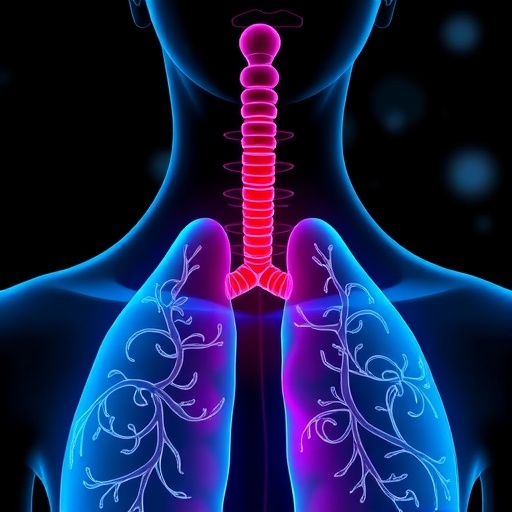
In a landmark study published this year, a team of researchers unveiled compelling evidence supporting the clinical benefits of sodium-glucose co-transporter-2 (SGLT2) inhibitors in patients suffering from the dual burden of chronic obstructive pulmonary disease (COPD) and diabetes mellitus. This innovative research adds a crucial piece to the complex puzzle of managing comorbidities in chronic disease, particularly given the intricate pathophysiology that intertwines metabolic and respiratory illnesses. The comprehensive analysis, appearing in Nature Communications, represents one of the first large-scale, clinical investigations to assess the therapeutic impact of SGLT2 inhibitors beyond their traditional glycemic control role, highlighting their potential in altering the prognosis for patients with COPD – a debilitating condition often accompanied by severe systemic inflammation and oxidative stress.
SGLT2 inhibitors, primarily developed as antidiabetic agents, markedly enhance urinary glucose excretion by targeting the SGLT2 proteins in the proximal renal tubules. This mechanism lowers plasma glucose levels independently of insulin secretion, offering notable cardioprotective and nephroprotective effects documented in previous cardiometabolic studies. However, the extension of their utility into respiratory disease management signifies a paradigm shift, inviting a reexamination of disease mechanisms that converge on inflammatory pathways and metabolic dysregulation. COPD itself is a chronic inflammatory disease characterized by irreversible airflow obstruction and progressive lung tissue destruction, frequently exacerbated by comorbid diabetes which worsens patient outcomes and complicates therapeutic regimens.
The investigative team, led by Wu et al., conducted a robust clinical trial encompassing a diverse patient cohort diagnosed concurrently with COPD and type 2 diabetes mellitus. The study utilized rigorous inclusion criteria and extended follow-up periods to evaluate the longitudinal effects of SGLT2 inhibition on disease progression, hospitalization rates, exacerbation frequency, and overall survival. Intriguingly, the findings demonstrated a statistically significant reduction in COPD exacerbations and respiratory-related hospitalizations among those receiving SGLT2 inhibitors compared to standard diabetes treatments. These benefits were attributed to the multifaceted actions of SGLT2 inhibitors, including attenuation of systemic inflammation, improvement in endothelial function, and possible modulation of metabolic substrates involved in muscle metabolism and respiratory muscle efficiency.
.adsslot_npN8kmuxVJ{width:728px !important;height:90px !important;}
@media(max-width:1199px){ .adsslot_npN8kmuxVJ{width:468px !important;height:60px !important;}
}
@media(max-width:767px){ .adsslot_npN8kmuxVJ{width:320px !important;height:50px !important;}
}
ADVERTISEMENT
Beyond their glucose-lowering properties, SGLT2 inhibitors appear to exert anti-inflammatory effects by reducing circulating pro-inflammatory cytokines, a critical factor in COPD pathogenesis. Chronic hyperglycemia and insulin resistance contribute to an inflammatory milieu that perpetuates lung tissue damage and exacerbates airflow limitation. The study’s data suggest that SGLT2 inhibitors may ameliorate this inflammation, thereby halting or slowing the progression of pulmonary deterioration. This mechanism may involve inhibition of the NLRP3 inflammasome, a multiprotein complex implicated in both diabetes-related systemic inflammation and COPD-related lung injury, establishing a biochemical link between these conditions that can be therapeutically targeted.
Another novel insight from the research relates to the cardiovascular benefits observed in this patient population. Patients with both COPD and diabetes are particularly vulnerable to cardiovascular events, a leading cause of mortality. SGLT2 inhibitors are known to enhance cardiac efficiency through mechanisms including osmotic diuresis, reduction of preload and afterload, and improvement of myocardial metabolism. Wu and colleagues noted a remarkable decrease in cardiovascular event rates, which likely contributed to improved overall survival statistics and quality of life in their study cohort. This cardiovascular advantage further strengthens the case for incorporating SGLT2 inhibitors into integrated treatment strategies targeting multiple comorbid conditions prevalent in COPD patients.
Renal function preservation also emerged as a notable secondary benefit, which is critical considering the adverse effects of impaired kidney function commonly observed in diabetic COPD patients. The nephroprotective trace of SGLT2 inhibitors may alleviate subclinical renal injury exacerbated by chronic inflammation and hypoxia inherent in COPD. The study’s longitudinal assessment confirmed stabilization of estimated glomerular filtration rates (eGFR) and reduction in albuminuria, markers indicative of sustained kidney health, offering additional protective layers against comorbidity progression and healthcare burden.
At a cellular level, the interplay between metabolic substrates and respiratory function under SGLT2 inhibition was explored through advanced biomarker profiling and spirometric evaluations. The enhancement of skeletal muscle function, particularly in respiratory muscles, appears to be a critical factor in the observed clinical improvements. Muscle wasting and weakness, common in advanced COPD, are worsened by hyperglycemia and insulin resistance. By improving systemic metabolism and reducing glucotoxicity, SGLT2 inhibitors may facilitate mitochondrial efficiency and aerobic capacity, translating into better exercise tolerance and respiratory mechanics, pivotal for patient rehabilitation.
The study also delved into the pharmacokinetic and safety profiles of SGLT2 inhibitors within this vulnerable patient group. Importantly, no significant increase in adverse events such as urinary tract infections or ketoacidosis was observed, alleviating previous concerns about their use in patients with compromised pulmonary function. The tolerability and safety demonstrated across various subpopulations underscore the feasibility of broader clinical adoption, especially given the dual benefits in controlling glycemic and respiratory disease parameters.
An intriguing dimension of the research was the observed modulation of the gut-lung axis, a burgeoning area of scientific inquiry. Dysbiosis associated with diabetes and COPD contributes to systemic inflammation and infection susceptibility. SGLT2 inhibitor therapy appeared to influence microbial composition and metabolite profiles beneficially, potentially reducing inflammation and enhancing immune defense mechanisms critical in both metabolic and respiratory health. This finding opens new avenues for personalized interventions capitalizing on microbiome-targeted therapies in conjunction with pharmacological agents.
The multidisciplinary nature of the research reflects an evolving understanding of chronic disease management, emphasizing the necessity of integrative approaches that transcend traditional organ-specific treatment paradigms. By targeting shared molecular and cellular pathways implicated in both diabetes and COPD, SGLT2 inhibitors represent a promising therapeutic nexus, exemplifying precision medicine principles aimed at improving patient-centric outcomes, reducing healthcare costs, and promoting longevity.
Future directions inspired by this study highlight the need for expansive, multicenter randomized controlled trials to validate these findings and establish definitive clinical guidelines. Furthermore, investigating the potential synergistic effects of SGLT2 inhibitors with existing COPD therapies, such as bronchodilators and corticosteroids, could optimize treatment efficacy and personalize therapeutic strategies. Investigations into long-term mechanistic effects, particularly involving pulmonary remodeling and fibrosis, may also yield transformative insights into chronic respiratory disease management.
In summary, the pioneering work by Wu and colleagues marks a significant advancement in our understanding of SGLT2 inhibitors’ role beyond diabetes control, emphasizing their utility in improving health outcomes for patients suffering from the complicating intersection of COPD and diabetes. Through rigorous clinical evaluation and mechanistic exploration, this study sets the stage for a redefinition of therapeutic standards, offering hope for enhanced quality of life and survival in a patient population historically challenged by limited effective treatment options.
As the prevalence of chronic diseases escalates globally, innovations such as these underscore the imperative of integrating metabolic and pulmonary care, harnessing the molecular versatility of emerging drugs to address the multifactorial nature of disease. The future of chronic disease therapeutics stands at this interdisciplinary crossroads, illuminated by research fostering holistic patient care and translational science breakthroughs.
Subject of Research: The clinical effectiveness of sodium-glucose co-transporter-2 inhibitors on the prognosis of patients with chronic obstructive pulmonary disease (COPD) and diabetes.
Article Title: The clinical effectiveness of sodium-glucose co-transporter-2 inhibitors on prognosis of patients with chronic obstructive pulmonary disease and diabetes.
Article References: Wu, JY., Hu, KC., Liu, MY. et al. The clinical effectiveness of sodium-glucose co-transporter-2 inhibitors on prognosis of patients with chronic obstructive pulmonary disease and diabetes. Nat Commun 16, 5478 (2025). https://doi.org/10.1038/s41467-025-60582-y
Image Credits: AI Generated
Tags: cardioprotective benefits of SGLT2 inhibitorschronic obstructive pulmonary disease treatmentdiabetes and respiratory disease comorbiditiesdual burden of COPD and diabetes.glycemic control and COPD outcomesinnovative research in chronic disease managementmetabolic and respiratory illness intersectionNature Communications study on SGLT2 inhibitorsnephroprotective effects of SGLT2 inhibitorsSGLT2 inhibitors in COPD managementsystemic inflammation in COPDtherapeutic impact of SGLT2 inhibitors





